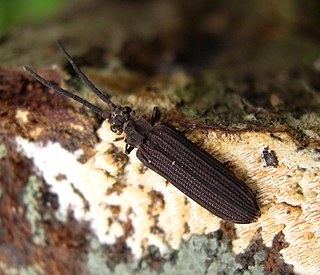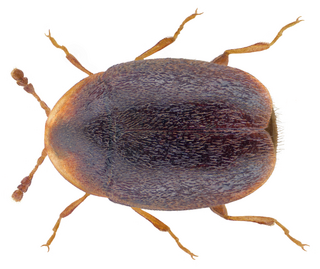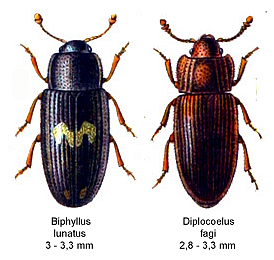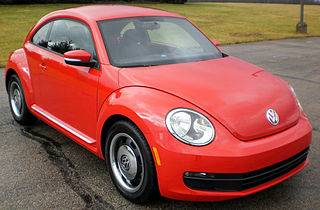
The Volkswagen Beetle—officially the Volkswagen Type 1, informally in German the Käfer, in parts of the English-speaking world the Bug, and known by many other nicknames in other languages—is a two-door, rear-engine economy car, intended for five occupants, that was manufactured and marketed by German automaker Volkswagen (VW) from 1938 until 2003.

Stag beetles are a group of about 1,200 species of beetles in the family Lucanidae, presently classified in four subfamilies. Some species grow to over 12 cm (4.7 in), but most are about 5 cm (2.0 in).

The Cupedidae are a small family of beetles, notable for the square pattern of "windows" on their elytra, which give the family their common name of reticulated beetles.

The Haliplidae are a family of water beetles who swim using an alternating motion of the legs. They are therefore clumsy in water, and prefer to get around by crawling. The family consists of about 200 species in 5 genera, distributed wherever there is freshwater habitat; it is the only extant member of superfamily Haliploidea. They are also known as crawling water beetles or haliplids.

Polyphaga is the largest and most diverse suborder of beetles. It comprises 144 families in 16 superfamilies, and displays an enormous variety of specialization and adaptation, with over 300,000 described species, or approximately 90% of the beetle species so far discovered.

Darkling beetle is the common name of the large family of beetles, Tenebrionidae. The number of species in the Tenebrionidae is estimated at more than 20,000 and the family is cosmopolitan in distribution.

The Dytiscidae – based on the Greek dytikos (δυτικός), "able to dive" – are the predaceous diving beetles, a family of water beetles. They occur in virtually any freshwater habitat around the world, but a few species live among leaf litter. The adults of most are between 1 and 2.5 cm (0.4–1.0 in) long, though much variation is seen between species. The European Dytiscus latissimus and Brazilian Megadytes ducalis are the largest, reaching up to 4.5 cm (1.8 in) and 4.75 cm (1.9 in) respectively. In contrast, the smallest is likely the Australian Limbodessus atypicali of subterranean waters, which only is about 0.9 mm (0.035 in) long. Most are dark brown, blackish, or dark olive in color with golden highlights in some subfamilies. They have short, but sharp mandibles. Immediately upon biting, they deliver digestive enzymes. The larvae are commonly known as water tigers. The family includes more than 4,000 described species in numerous genera.

The Volkswagen New Beetle is a compact car, introduced by Volkswagen in 1997, drawing heavy inspiration from the exterior design of the original Beetle. Unlike the original Beetle, the New Beetle has its engine in the front, driving the front wheels, with luggage storage in the rear. Many special editions have been released, such as the Malibu Barbie New Beetle.
The family Archeocrypticidae is a small group of beetles with no vernacular common name, though recent authors have coined the name cryptic fungus beetles. Adults and larvae seems to be saprophagous and are often found in plant litter. Worldwide, about 10 genera and 50 species are found, most species are pantropical. Enneboeus caseyi has been recorded from the American South, Central America, and Mexico. About 20 species are found in Australia, in the genera Enneboeus and Australenneboeus.

The family Mycteridae is a small group of beetles with no vernacular common name, though recent authors have coined the name palm and flower beetles. The family Mycteridae is distributed worldwide. There are about 30 genera and 160 species. About 20 species are found in Australian, species of three genera are found in North America

The family Prostomidae is a small group of beetles with no vernacular common name, though recent authors have coined the name jugular-horned beetles. They are often found in dead wood. The family consist of two genera with about 20 species. Prostomis mandibularis is known from North America. Other species of Prostomis are found in Africa, the Pacific region and East Asia. Species of Dryocora are known from New Zealand, Australia and Tasmania.

Cleridae are a family of beetles of the superfamily Cleroidea. They are commonly known as checkered beetles. The family Cleridae has a worldwide distribution, and a variety of habitats and feeding preferences.

Corylophidae is a family of minute hooded beetles, sometimes called minute fungus beetles, in the order Coleoptera. There are about 18 genera and at least 120 described species in Corylophidae.

Ptiliidae is a family of very tiny beetles with a cosmopolitan distribution. This family contains the smallest of all beetles, with a length when fully grown of 0.3–4.0 millimetres (0.01–0.16 in). The weight is approximately 0.4 milligrams. They are colloquially called featherwing beetles, because the hindwings are narrow and feathery. The eggs are very large in comparison to the adult female so only one egg at a time can be developed and laid. Parthenogenesis is exhibited by several species.

Glaphyridae is a family of beetles, commonly known as bumble bee scarab beetles. There are eight extant genera with about 80 species distributed worldwide and two extinct genera described from the fossil record of China.

Biphyllidae or False Skin Beetles is a family of beetles, in the suborder Polyphaga. Worldwide, about 195 species are known. They live under the bark of dead trees and feed on fungi. It contains the following genera:

Stenotrachelidae, commonly called false longhorn beetles is a family of beetles, in the large suborder Polyphaga.

The Volkswagen Beetle is a small family car manufactured and marketed by Volkswagen introduced in 2011 for the 2012 model year, as the successor to the New Beetle launched in 1997. It features a lower profile while retaining an overall shape recalling the original Volkswagen Type 1 Beetle.
Scelolyperus lecontii is a species of leaf beetle in the family Chrysomelidae. It is found in North America.


















